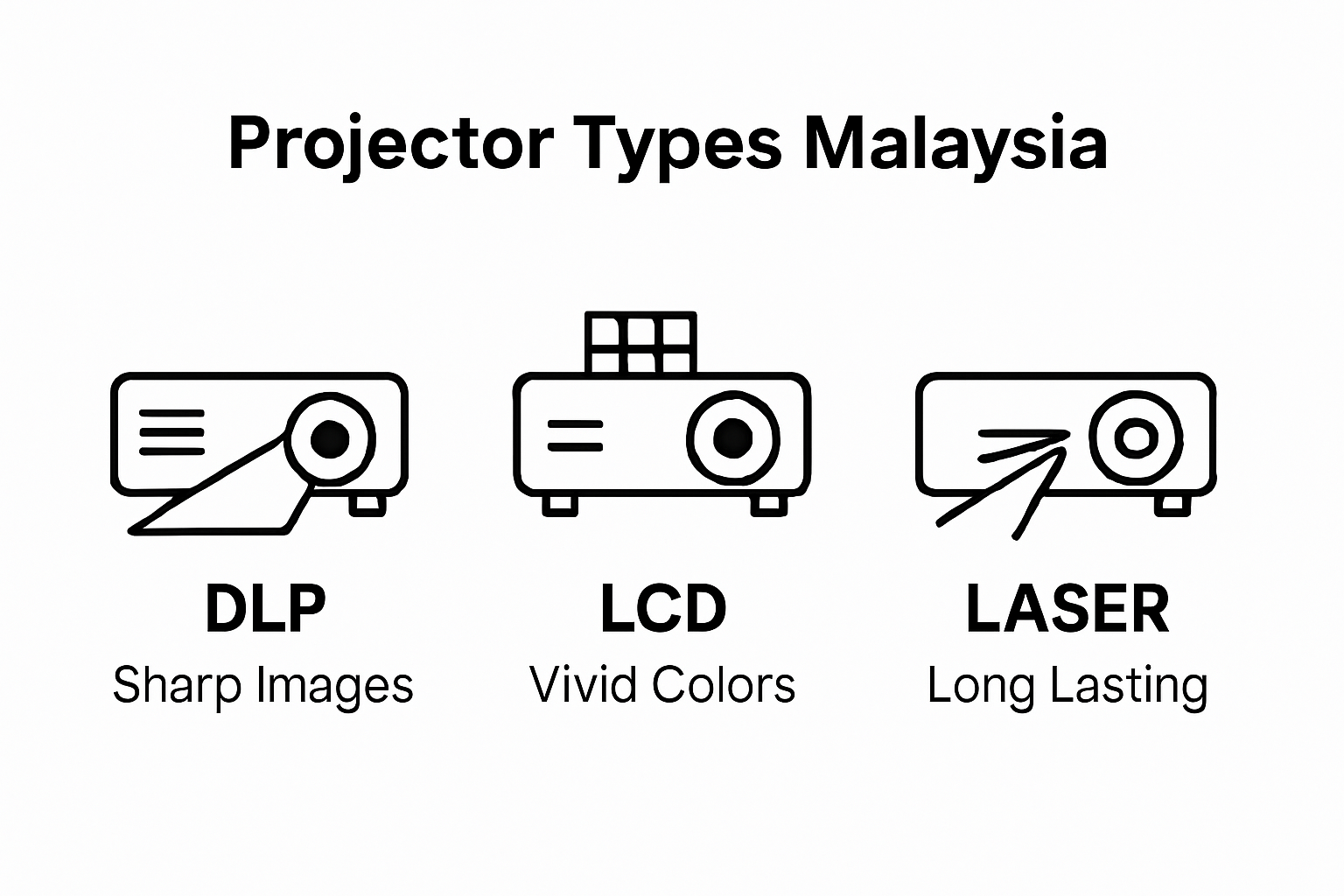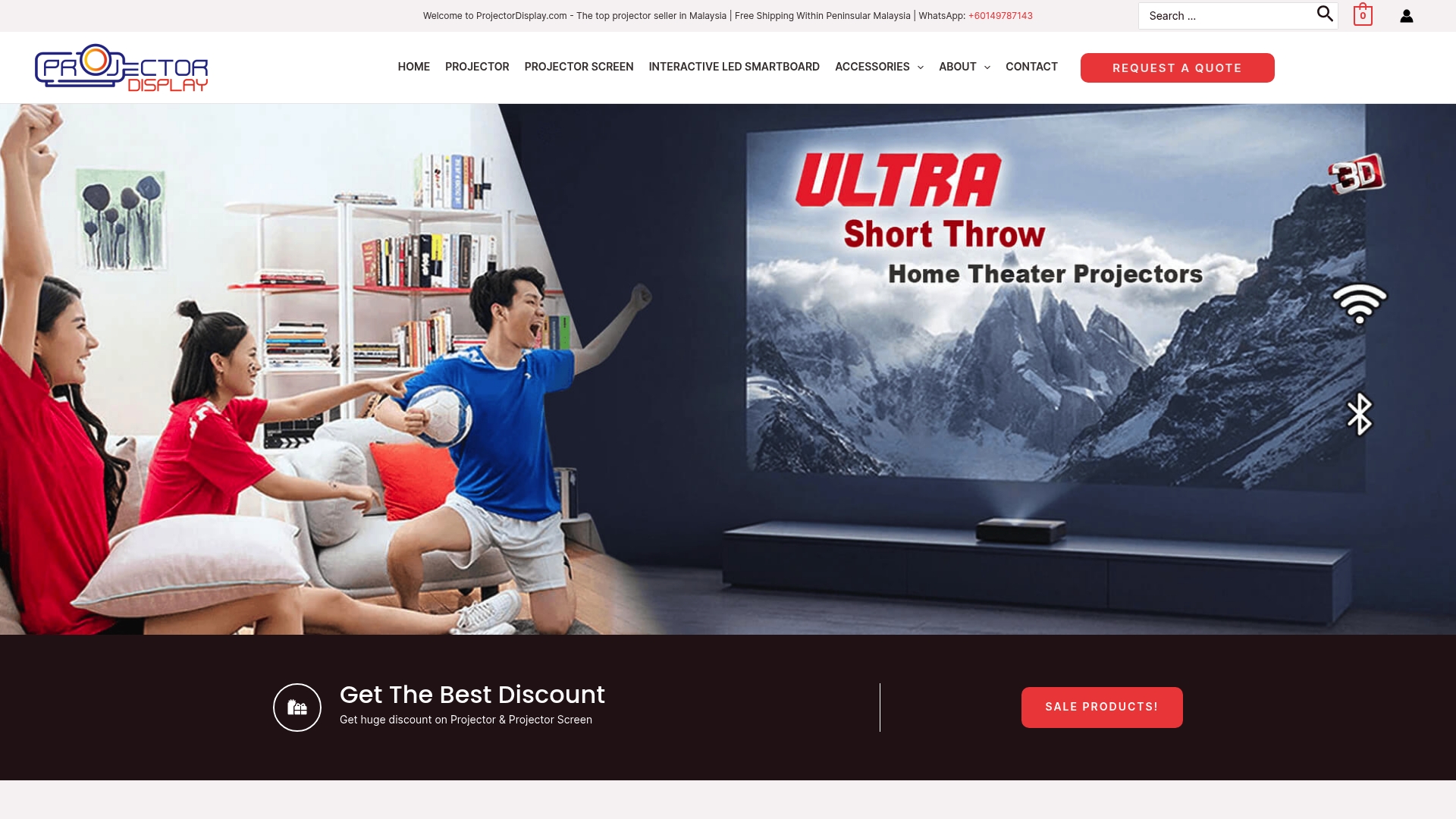Projectors have turned regular classrooms and living rooms across Malaysia into vibrant visual hubs. More than 70 percent of Malaysian schools have adopted digital projection systems and the rate keeps climbing every year. But most people think projectors are simply about making the picture bigger. The real shift is how these devices are transforming the way Malaysians learn, work, and enjoy entertainment in ways that go far beyond just screen size.
Table of Contents
- What Is A Projector And Its Role In Malaysia?
- The Importance Of Projector In Home Entertainment And Education
- How Projector Work: Key Technologies Explained
- Different Types Of Projector: Features And Applications
- Current Trends In Projector Malaysia: What To Look For
Quick Summary
| Takeaway | Explanation |
|---|---|
| Projectors enhance education in Malaysia. | They facilitate interactive learning, increasing student engagement and aiding knowledge retention through dynamic presentations. |
| Home entertainment is transformed by projectors. | Projectors create large-screen experiences, offering high quality visual displays in personal settings without expensive setups. |
| Understanding projector types is vital. | Different projectors, like DLP and LCD, serve specific needs; matching technology to use case is crucial for optimal performance. |
| Smart connectivity is a key trend. | Modern projectors now feature wireless mirroring, streaming support, and smart assistants, enhancing multimedia integration and usability. |
| Technological advancements are rapid. | The Malaysian market sees improvements like 4K resolution and energy-efficient modes, addressing diverse user requirements effectively. |
What is a Projector and Its Role in Malaysia?
A projector is an advanced optical device designed to display visual content onto a larger surface, typically a screen or wall, by using light and lens technology. In Malaysia, projector technology has rapidly transformed various sectors including education, business, entertainment, and home multimedia environments.
Understanding Projector Technology
Projectors function by converting electrical signals into visual images through complex optical mechanisms. Essentially, these devices take digital or analog input from computers, smartphones, or media players and project enlarged, high-resolution images using specialized lamp or laser technologies.
The core functionality involves several key processes:
- Generating bright light through specialized bulbs or laser sources
- Passing light through color filters or digital imaging chips
- Precisely focusing and enlarging images using advanced lens systems
- Maintaining color accuracy and image sharpness across different display surfaces
In the Malaysian context, projector technology has become increasingly sophisticated, supporting multiple resolution standards like HD, Full HD, and 4K, enabling crisp and detailed visual experiences across different applications.
Projector Applications in Malaysian Settings
Malaysian professionals and institutions have widely adopted projector technology across multiple domains. According to research from the Malaysian Educational Technology Association, projector integration has significantly enhanced learning environments by providing interactive and engaging multimedia presentation capabilities.
Key application areas include:
- Educational institutions using projections for interactive classroom learning
- Corporate environments for dynamic business presentations
- Home entertainment systems creating immersive cinematic experiences
With technological advancements, Malaysian users can now select from various projector types including portable models perfect for mobile professionals, short-throw designs for compact spaces, and high-luminosity models suitable for bright environments.
Projectors represent more than just display technology in Malaysia they are transformative tools bridging communication, education, and entertainment through powerful visual storytelling capabilities.
The Importance of Projector in Home Entertainment and Education
Projectors have emerged as transformative technologies that fundamentally reshape how Malaysians experience visual content across home and educational environments. By providing larger-than-life visual experiences, these devices transcend traditional display limitations, creating immersive and engaging multimedia interactions.
Enhanced Learning Experiences
In educational settings, projector technology revolutionizes traditional learning methodologies. According to research from the Malaysian Educational Technology Association, interactive projection systems significantly improve student engagement and knowledge retention by presenting complex information through dynamic visual narratives.
Key educational benefits include:
- Enabling multimedia content presentation for diverse learning styles
- Supporting interactive classroom demonstrations
- Facilitating group learning and collaboration
- Allowing seamless integration of digital educational resources
Teachers can now transform abstract concepts into visually compelling presentations, making learning more accessible and interesting for students across different age groups and educational levels.
Home Entertainment Transformation
In home entertainment, projector technology has redefined multimedia consumption. Modern Malaysian households are increasingly adopting high-quality projection systems that provide cinema-like experiences within personal spaces.
Home entertainment projector advantages encompass:
- Creating large-screen viewing experiences without expensive television installations
- Supporting multiple media input sources
- Offering flexible screen size adjustments
- Providing superior visual quality for gaming and movie watching
With advancements in projection technology, Malaysian consumers can now enjoy professional-grade visual experiences that were previously limited to commercial cinema environments, all within the comfort of their living rooms.

Projectors represent more than technological devices they are powerful tools that bridge educational innovation and entertainment excellence, transforming how Malaysians interact with visual content across personal and professional domains.
How Projector Work: Key Technologies Explained
Projector technology represents a sophisticated combination of optical engineering and digital signal processing, transforming digital information into large visual displays through intricate technological mechanisms. Understanding the core principles behind projection technologies helps Malaysian users appreciate the complexity of these remarkable devices.
Optical Projection Mechanisms
At its fundamental level, a projector functions by converting electrical signals into visible light images through precise optical pathways. Modern projection systems utilize advanced technologies that manipulate light with extraordinary precision, creating high-resolution visual experiences.
The primary projection technologies include:
- Digital Light Processing (DLP): Uses microscopic mirrors to reflect light
- Liquid Crystal Display (LCD): Passes light through liquid crystal panels
- Laser Projection: Generates images using laser light sources
- LED Projection: Utilizes light-emitting diodes for illumination
Each technology offers unique advantages in terms of color reproduction, brightness, and energy efficiency, catering to different user requirements in Malaysian markets.
Light Generation and Image Formation
The projection process involves complex interactions between light sources, color wheels, and optical components. According to optical engineering research, the fundamental steps include:
- Generating intense light through specialized bulbs or laser sources
- Separating white light into primary color components
- Modulating light signals using digital imaging chips
- Precisely focusing and enlarging images through advanced lens systems
Modern Malaysian projector technologies have significantly improved color accuracy, resolution, and brightness, enabling near-cinematic visual experiences across various settings from home entertainment to professional presentations.
Projector technologies continue to revolutionize visual communication, providing increasingly sophisticated methods of transforming digital information into immersive, large-scale visual experiences that expand our perception of multimedia interactions.
Different Types of Projector: Features and Applications
Projector technologies have evolved dramatically, offering diverse solutions for Malaysian users across professional, educational, and entertainment domains. Understanding the unique characteristics of different projector types enables informed decision making for specific visual display requirements.
Projection Technology Categories
The Malaysian market offers multiple projector technologies, each designed to address specific performance needs. According to advanced optical research, these technologies differ significantly in their operational mechanisms and visual output capabilities.
Key projector technology categories include:
- Digital Light Processing (DLP): Utilizes microscopic mirrors for precise image rendering
- Liquid Crystal Display (LCD): Passes light through specialized liquid crystal panels
- Liquid Crystal on Silicon (LCoS): Combines LCD and semiconductor technologies
- LED and Laser Projection: Uses advanced light-emitting technologies
Performance and Application Considerations
Comprehensive projector selection guidance highlights the importance of matching projector technologies with specific use cases. Different projector types excel in various environments based on their unique technological characteristics.

Projector performance factors include:
- Brightness levels suitable for different ambient lighting conditions
- Color reproduction accuracy
- Native resolution and image clarity
- Throw distance and installation flexibility
For instance, DLP projections work excellently in home theater settings, while LCD technologies might be preferred in brightly lit educational environments. Laser projections offer superior longevity and consistent performance across extended usage periods.
The following table compares the main projector technologies mentioned in the article, summarizing their mechanisms, strengths, and typical applications. This helps readers understand the differences at a glance.
| Projector Technology | How It Works | Key Strengths | Common Applications |
|---|---|---|---|
| DLP (Digital Light Processing) | Uses microscopic mirrors to reflect light | High contrast, sharp images | Home theater, business |
| LCD (Liquid Crystal Display) | Passes light through liquid crystal panels | Accurate colors, bright output | Classrooms, offices |
| LCoS (Liquid Crystal on Silicon) | Combines LCD and silicon reflection | Smooth images, high resolution | Professional, high-end settings |
| LED Projection | Uses light-emitting diodes for illumination | Energy efficient, long lifespan | Portable and compact projectors |
| Laser Projection | Generates images using laser light sources | Brightness, durability | Large venues, advanced home use |
The Malaysian market continues to witness rapid technological advancements, with manufacturers developing increasingly sophisticated projection solutions that cater to the nuanced requirements of diverse user segments, from corporate professionals to home entertainment enthusiasts.
This table organizes the performance considerations and key features to evaluate when selecting a projector for Malaysian settings. It provides a concise checklist based on specific needs highlighted in the article.
| Feature | Description | Why It Matters |
|---|---|---|
| Brightness Levels | Suitable for ambient lighting conditions | Ensures clear images in different environments |
| Color Reproduction | Accuracy and vibrancy of displayed colors | Impacts viewing realism and engagement |
| Resolution | Native display clarity (HD, Full HD, 4K) | Affects detail and crispness of visuals |
| Throw Distance | Distance needed between projector and screen | Influences installation and room compatibility |
| Installation Flexibility | Mounting and placement options | Supports a range of user setups |
Current Trends in Projector Malaysia: What to Look For
The Malaysian projector market is experiencing rapid technological transformation, with innovative features and sophisticated technologies reshaping visual display solutions across various sectors. Understanding the current trends helps consumers and professionals make informed purchasing decisions aligned with emerging technological capabilities.
Smart Connectivity and Advanced Features
Modern projector technologies are increasingly emphasizing smart connectivity and integrated features. According to market research insights, Malaysian consumers are gravitating towards projector systems that offer comprehensive digital integration and seamless multimedia experiences.
Key smart connectivity trends include:
- Built-in wireless screen mirroring capabilities
- Integrated streaming platform support
- Voice control and smart assistant compatibility
- Enhanced network connectivity options
These advanced features transform projector technologies from simple display devices into comprehensive multimedia platforms that integrate smoothly with contemporary digital ecosystems.
Performance and Technological Innovations
Comprehensive projector selection guidance highlights emerging performance trends that are reshaping the Malaysian market. Consumers are increasingly prioritizing projector technologies that deliver superior visual experiences with minimal complexity.
Critical performance considerations include:
- Ultra-short throw projection capabilities
- High dynamic range (HDR) image processing
- Laser light source technologies
- 4K and higher resolution displays
- Energy-efficient operational modes
The Malaysian projector landscape continues to witness remarkable technological advancements, with manufacturers developing increasingly sophisticated solutions that cater to diverse user requirements across professional, educational, and entertainment domains.
Find the Right Projector Solution for Your Malaysian Space
Are you struggling to choose the best projector that fits your exact needs in Malaysia? The article explains how projectors can transform learning, business, and home entertainment, but finding reliable equipment, optimal image quality, and tailored features can be overwhelming. Many readers feel unsure about screen size, compatibility, wireless functions, and maximizing visual impact. The right projector screen can make all the difference for a crisp, immersive viewing experience in your environment. Explore our dedicated Projector Screen collection designed for educational, business, and home theater applications.

At ProjectorDisplay.com you will discover a complete selection of projectors, screens, and accessories curated for Malaysian homes, schools, and offices. Our products match what you learned in this guide—whether you want wireless connectivity or cinema-level visuals. Visit our Sound Systems category to add powerful audio to your setup and unlock a full multimedia experience. Now is the perfect time to upgrade your visual solutions. Take the next step and bring professional-quality projection into your space today.
Frequently Asked Questions
What are the different types of projectors available in Malaysia?
There are several types of projectors available in Malaysia, including Digital Light Processing (DLP), Liquid Crystal Display (LCD), Liquid Crystal on Silicon (LCoS), LED, and Laser projectors. Each type has unique characteristics suited for different applications.
How do projectors enhance the educational experience?
Projectors enhance the educational experience by providing larger-than-life visuals that support multimedia content presentation, interactive demonstrations, and group engagement, thus improving knowledge retention and making learning more accessible.
What should I consider when choosing a projector for home entertainment?
When choosing a projector for home entertainment, consider factors such as brightness levels for your space, resolution quality (HD, Full HD, 4K), throw distance, and compatibility with various media sources. These will ensure an optimal viewing experience.
How does projector technology work?
Projector technology works by converting electrical signals into visible light images through advanced optical mechanisms that include light generation, color separation, and image projection via specialized lenses. This process enables the display of large-scale visuals with high resolution.

